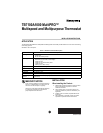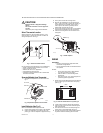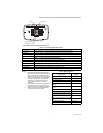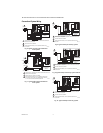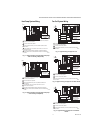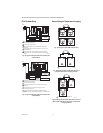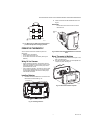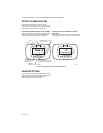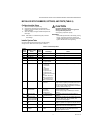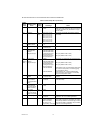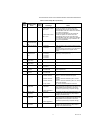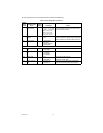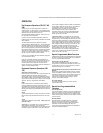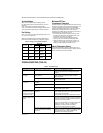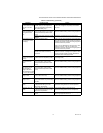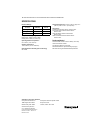TB7100A1000 MULTIPRO™ MULTISPEED AND MULTIPURPOSE THERMOSTAT
13 62-0273—05
OPERATION
Fan Sequence Operations (ISU 347, 348,
349)
If heat pump or conventional application modes are
enabled in ISU 170, then ISU 347 is not available for fan
ramp algorithm. The fan operates as a default ON/AUTO
selection that works the same way as our
CommercialPRO TB7220 thermostat. There is only one
fan relay output that is activated.
If PTAC or fan coil thermostat application modes are
enabled in ISU 170, then ISU 347 is available for installer
setup selection.
The thermostat comes factory default with the fan
ramping algorithm enabled (ISU 347). This gives the user
the ability to select Auto-Lo-Med-Hi option in ISU 348 or
Auto only option in ISU 348. Auto sets the thermostat into
the fan ramping algorithm mode and automatically sets
the sufficient speed for PI control. Auto also automatically
shuts the fan off when there is not a call for heating or
cooling. If the user decides to disable ISU 347, then the
fan will only have Lo-Med-Hi option available.
If ISU 347 is not enabled, then ISU 348 does not appear
as a user selection choice.
If ISU 347 is enabled, then ISU 349 is available as a
selection choice. The user can select either a 2 hour or 4
hour timer fan reset function. The fan will reset from a
constant speed to auto mode after the time period
expires. If ISU 347 is not enabled, then ISU 349 does not
appear as a user selection choice.
Equipment Sequence Operations (ISU
170)
Heat Pump and Conventional
Heat Pump and conventional use a single fan speed. The
single fan speed label will be G, located on the G1
terminal relay output. Label should read G/Gl to help out
the installers. Display on the thermostat for these modes
will give the Fan On/Auto option. There is no fan ramping
algorithm, ISU 347, 348, 349 are not available.
PTAC
PTAC modes 10 and 11 will have the same selection
options available as the heat pump selection options. The
only difference is that the PTAC options have a Lo and Hi
speed fan output instead of single speed output and that it
follows the fan sequencing described above with ISU 347,
348, 349.
4 Pipe
4 pipe is treated similar to 1H/1C conventional. It follows
the fan sequencing described above with ISU 347, 348,
349.
2 Pipe
There are two different 2 pipe modes - 2 pipe only and 2
pipe with reheat.
2 pipe only - 2 pipe modes do not contain the ability to
have automatic changeover. They are manual
changeover only. The thermostat will have a priority when
choosing a system mode (heat or cool). When ISU 340
has a 2 pipe changeover sensor enabled, the thermostat
screen system mode will lock on heat or cool (whatever
the changeover sensor is communicating to the
thermostat). If ISU 340 does not have a changeover
sensor enabled, then the system mode from the
thermostat screen can manually be adjusted between
heat or cool. It follows the fan sequencing described
above with ISU 347, 348, 349.
2 pipe with reheat - 2 pipe modes do not contain the
ability to have automatic changeover. They are manual
changeover only. The thermostat will have a priority when
choosing a system mode (heat or cool). When ISU 340
has a 2 pipe changeover sensor enabled, the thermostat
screen system mode will lock on heat only. When the 2
pipe changeover sensor is sensing cool mode, the user
can adjust to heating mode which will bring on the
auxiliary heat. If ISU 340 does not have a changeover
sensor enabled, then the system mode from the
thermostat screen can manually be adjusted between
heat or cool. It follows the fan sequencing described
above with ISU 347, 348, 349.
Special Programmable Mode Functions
Installer Setup 160 allows the thermostat to be configured
for either a mode with a programmable 7 day schedule or
as a non-programmable thermostat.
Preoccupancy purge (ISU 185)
This feature is available only when the thermostat is
configured as a programmable schedule and when a fan
is used. The fan will run 1-3 hours before the occupied
schedule starting time to circulate air.
Override Button, Temporary Override (Duration Limit
ISU 535)
While in the programmable schedule mode, an override
button is available to perform temporary override control.
The default override time can be configured through ISU
535. Lockout configuration via ISU 670 can provide
restrictions on access to setpoint changes, system
changes, and schedule changes.
No remote setback
The remote setback feature only works in the non-
programmable mode.
Special Non-Programmable Mode
Functions
Override (Optional)
The override feature is optional in the non-programmable
mode. The override can be configured through ISU 342.
When the override is activated in the non-programmable
mode it will temporarily override to a new setpoint until the
end time expires.
Remote Setback
Remote Setback is available (ISU 340). Occupancy
sensors, manual time clock inputs, and DDC night
setback can be used to provide inputs to setback the
thermostat. Unoccupied heating (ISU 343) and
unoccupied cooling (ISU 346) setpoints are available to
configure the setback setpoints.



